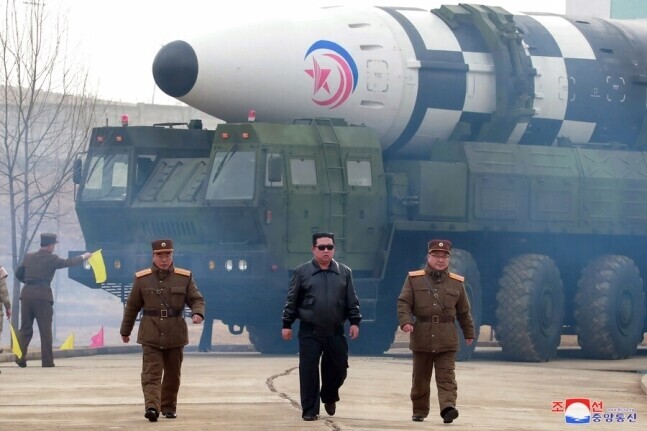hankyoreh
Links to other country sites 다른 나라 사이트 링크
N. Korea fires ICBM for first time since May, heightening tensions

North Korea fired one intercontinental ballistic missile (ICBM) and two short-range ballistic missiles (SRBM) into the East Sea on Thursday. North Korea has not fired an ICBM since May 25, making Thursday’s launch the first in roughly five months.
With the South Korean and US air forces announcing that they would extend their Vigilant Storm joint air drills past their original end date of Friday, tensions are escalating on the Korean Peninsula.
South Korea’s Joint Chiefs of Staff announced that they had detected a long-range ballistic missile launched toward the East Sea at 7:40 am on Thursday, and two short-range ballistic missiles at 8:39 am.
According to the Joint Chiefs, the ICBM flew a distance of around 760 km, reaching an altitude of 1920, and a top speed of Mach 15, while the SRBM flew 330 km and its maximum altitude was 70 km.
However, the ICBM fell into the East Sea after separating at the second stage, signaling that it failed to follow a normal flight path. The Joint Chiefs estimated this missile to be a Hwasong-17, considered to belong to the ICBM class of missiles.
North Korea launched 25 missiles on Wednesday in protest of South Korea and the US’ joint air drill, and one of those missiles fell south of the Northern Limit Line (NLL) for the first time since the armistice.
President Yoon Suk-yeol attended an emergency National Security Council meeting where he instructed that “every effort be made toward the South Korea-US combined defense posture to ensure not even the slightest gap in protecting our people’s lives and safety.”
The air forces of South Korea and the US have decided to extend the Vigilant Storm joint air drills past their original end date on Friday. This drill is the largest ever, involving 240 South Korean and US military aircraft.
By Shin Hyeong-cheol, staff reporter
Please direct questions or comments to [english@hani.co.kr]

Editorial・opinion
![[Editorial] Penalties for airing allegations against Korea’s first lady endanger free press [Editorial] Penalties for airing allegations against Korea’s first lady endanger free press](https://flexible.img.hani.co.kr/flexible/normal/500/300/imgdb/original/2024/0502/1817146398095106.jpg) [Editorial] Penalties for airing allegations against Korea’s first lady endanger free press
[Editorial] Penalties for airing allegations against Korea’s first lady endanger free press![[Editorial] Yoon must halt procurement of SM-3 interceptor missiles [Editorial] Yoon must halt procurement of SM-3 interceptor missiles](https://flexible.img.hani.co.kr/flexible/normal/500/300/imgdb/child/2024/0501/17145495551605_1717145495195344.jpg) [Editorial] Yoon must halt procurement of SM-3 interceptor missiles
[Editorial] Yoon must halt procurement of SM-3 interceptor missiles- [Guest essay] Maybe Korea’s rapid population decline is an opportunity, not a crisis
- [Column] Can Yoon steer diplomacy with Russia, China back on track?
- [Column] Season 2 of special prosecutor probe may be coming to Korea soon
- [Column] Park Geun-hye déjà vu in Yoon Suk-yeol
- [Editorial] New weight of N. Korea’s nuclear threats makes dialogue all the more urgent
- [Guest essay] The real reason Korea’s new right wants to dub Rhee a founding father
- [Column] ‘Choson’: Is it time we start referring to N. Korea in its own terms?
- [Editorial] Japan’s rewriting of history with Korea has gone too far
Most viewed articles
- 160% of young Koreans see no need to have kids after marriage
- 2Months and months of overdue wages are pushing migrant workers in Korea into debt
- 3[Editorial] Penalties for airing allegations against Korea’s first lady endanger free press
- 4[Reporter’s notebook] In Min’s world, she’s the artist — and NewJeans is her art
- 51 in 3 S. Korean security experts support nuclear armament, CSIS finds
- 6Bills for Itaewon crush inquiry, special counsel probe into Marine’s death pass National Assembly
- 7[Guest essay] Maybe Korea’s rapid population decline is an opportunity, not a crisis
- 8Cracks found in containment building of UAE nuclear power plant built by S. Korean companies
- 9S. Korea discusses participation in defense development with AUKUS alliance
- 10[Special report- Part I] Worked to death at the ripe age of 22